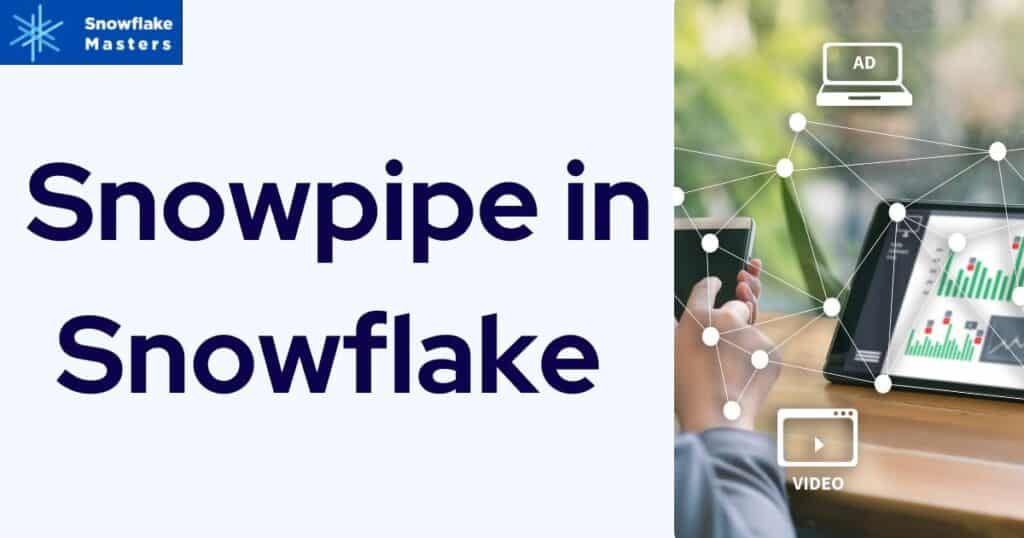Real-Time Analytics at Your Fingertips: How Snowpipe in Snowflake Eases Data Ingestion
Snowpipe in Snowflake

Real-time analytics has evolved into a crucial component when making data-driven business decisions in today’s world. With the constant influx of data, enterprises need help promptly processing and turning it into actionable insights.
However, Snowpipe in Snowflake is a game-changer in data ingestion by automating the process, and it empowers organizations to perform real-time analytics effortlessly. Let’s dive into how Snowpipe revolutionizes data ingestion and enables seamless real-time business analytics.
Table of contents
- Introduction
- What is snow pipe in Snowflake?
- The Significance of Real-Time Analytics
- Data Ingestion Challenges and Limitations
- Overview of Snowpipe in Snowflake
- How Snowpipe Eases Data Ingestion
- How to create snow pipe in Snowflake
- Snowpipe example
- Snowpipe cost
- Relevant Statistics and Market Trends
- Diverse Perspectives on Snowpipe
- Conclusion
Introduction
In today’s business landscape, organizations face intense competition, and those that leverage their data to make informed decisions can stand out from their competitors. However, making data-based decisions is only possible if businesses can access real-time analytics.
Real-time analytics enables enterprises to act on opportunities and challenges quickly, providing relevant insights at any moment. However, data ingestion can be complex and challenging, but Snowflake’s Snowpipe can ease this process significantly.
What is a snow pipe in Snowflake?
Snowpipe is a tool in Snowflake that allows you to load data from files into Snowflake tables in real time. It makes ingesting data easier by continuously checking for new files in a designated location. As soon as a new file is detected, Snowpipe starts loading the data, ensuring that it happens almost instantly.
Using Snowpipe, you create a “pipe” like a container. Using a COPY statement, you define how the data should be loaded inside the pipe. This statement tells Snowflake where to find the data files and where to put the data in your tables. Snowpipe can handle different types of data, including JSON and Avro files.
Snowpipe is designed to be fast and efficient.
It can load data within minutes after new files are added to the designated location, so you don’t have to wait for scheduled data loads. That allows you to access the latest data for real-time analysis and decision-making.
Snowpipe is designed to be user-friendly, with a simple setup process that requires minimal maintenance. Once you’ve configured the pipe and set up the data loading rules, Snowpipe handles the rest automatically. This automation reduces the need for manual intervention, saving time and effort for data engineers and administrators. Additionally, Snowpipe integrates seamlessly with Snowflake’s overall architecture, ensuring compatibility with other Snowflake features and tools.
Another benefit of Snowpipe is its scalability. Whether you’re dealing with small or large volumes of data, Snowpipe can handle the load efficiently. It automatically scales resources based on demand, ensuring that data ingestion remains fast and reliable even during peak usage periods. This scalability is particularly advantageous for organizations with fluctuating data volumes or growing data needs. By leveraging Snowpipe, businesses can easily adapt to changing data requirements without sacrificing performance or reliability.
The Significance of Real-Time Analytics
Real-time analytics enables businesses to process and analyze data as it is generated, eliminating lag time in processing and enhancing their decision-making processes. With real-time analytics, businesses can track data in real-time to gain insights into customer behaviour, track market trends, and optimize their business performance. By embracing real-time analytics, businesses can drive growth, enhance customer satisfaction, and thrive in today’s competitive world.
Data Ingestion Challenges and Limitations
Although Snowpipe offers an efficient and automated approach to data ingestion, there are still some challenges and limitations that organizations should be aware of. These include:
- Data Volume: Snowpipe provides real-time ingestion capabilities, but handling large data volumes can be challenging. High-velocity data streams or significant data sources may require additional resources, such as compute capacity or network bandwidth, to ensure efficient ingestion.
- Data Formats: Snowpipe is optimized to ingest data in specific formats. Thus, ingesting data in a different format may require additional transformation processes, adding complexity to the ingestion process.
- Data Sources: Snowpipe can ingest data from several sources, including databases, data files, and streams. However, organizations may store data in other sources not natively supported by Snowpipe. In such cases, additional integrations or custom solutions may be needed.
- Costs: Ingesting data continuously in real-time can be costly. Snowpipe usage is based on the amount of ingested data and the frequency of the polling intervals. Thus, larger volumes of data, more frequent polling, or increased resource usage can lead to higher costs.
- Security: Snowpipe provides robust and secure data transfer protocols, but some data privacy and compliance challenges may still apply. Ensuring proper security protocols and access controls are in place for incoming data streams is essential.
To address these challenges, organizations using Snowpipe should plan and design the data ingestion process carefully. These should involve understanding the data sources, formats, and volumes and ensuring that the proper infrastructure and configurations are in place to handle incoming data streams efficiently.
Moreover, ongoing optimization and monitoring of resource usage, costs, security, and compliance should be regularly carried out to ensure smooth and efficient data ingestion.
Overview of Snowpipe in Snowflake
Snowflake’s Snowpipe is a powerful real-time data ingestion tool that offers businesses an automated, efficient, and optimized solution for loading and accessing their data. With Snowpipe, users can load data in real-time without complex integration pipelines, saving valuable time and resources by removing manual intervention.
One key benefit of Snowpipe is its ability to simplify the data ingestion process. Without manual intervention or complex pipelines, Snowpipe streamlines data loading for users, enabling them to access critical information instantaneously for analytics and decision-making. This automated approach saves significant time, reduces manual errors, and allows businesses to make timely decisions based on the most up-to-date information.
Snowflake’s Snowpipe offers a valuable solution for businesses looking to streamline their data ingestion processes, enabling them to quickly and efficiently load data in real-time without manual intervention or complex integration pipelines.
How Snowpipe Eases Data Ingestion
Snowpipe simplifies data ingestion through its automated and efficient approach to real-time data loading. This powerful tool monitors data sources, including databases and files, to detect new data. Once new data is identified, Snowpipe automatically ingests it into Snowflake’s data cloud platform, making it immediately available for analysis.
By automating the data ingestion process, Snowpipe eliminates the need for manual intervention, simplifying the overall data-loading process. This streamlined approach removes the complexities of setting up and managing intricate integration pipelines, saving valuable time and resources for businesses.
Additionally, Snowpipe’s automation ensures businesses can access real-time data insights promptly, empowering them to make informed decisions and drive efficient business operations.
How to create a snow pipe in Snowflake
To create a Snowpipe in Snowflake, follow these steps:
- Create a Stage: First, create a stage to serve as the location where Snowpipe will monitor for new data files. You can create a stage using the SnowSQL command–line client or the Snowflake web interface. Make sure to specify the appropriate parameters, such as the storage location, file format, and access permissions.
- Grant Permissions: Grant necessary permissions to the Snowflake user or role that will be used for Snowpipe operations. This user or role should have privileges to read files from the stage and insert data into the target table.
- Create a Pipe: Using SnowSQL or the web interface, create a Snowpipe object (often called a “pipe”) in Snowflake. The pipe contains a COPY statement that defines the source stage and target table for data ingestion. It also specifies optional parameters like error handling, file format, and naming conventions.
- Activate the Pipe: After creating the pipe, activate it to start the real-time ingestion process. Activation makes the pipe start monitoring the designated stage for new data files. Once a new file is detected, Snowpipe automatically loads the data into the target table.
That’s it! You have successfully created a Snowpipe in Snowflake. From here on, Snowpipe will continuously monitor the specified stage for new data files and automatically load them into the target table as they appear.
Remember to regularly monitor the job history and set up appropriate alerts to ensure smooth operation and troubleshoot any potential issues during the data ingestion.

Snowpipe example
Imagine an e-commerce website that generates a continuous stream of customer transaction data. You must ingest this data in real-time to gain insights into customer behaviour and optimize your marketing strategies. Snowpipe in Snowflake simplifies and automates the process. Here’s how it works:
- Setting up Snowpipe: Create a stage in Snowflake to serve as the location for ingesting data. This stage acts as a repository for data files. You can create a stage using the Snowflake web interface or the SnowSQL command-line client.
- Configuring Snowpipe: Create a Snowpipe object in Snowflake once the stage is established. This object defines the rules for data ingestion from the stage. You can specify the file format, naming conventions, and other relevant parameters. Snowflake provides a SQL-based syntax to create and configure Snowpipe objects easily.
- Continuous data ingestion: Once Snowpipe is configured, it monitors the designated stage for new data. As soon as a new data file appears, Snowpipe automatically detects it and initiates the ingestion process into your Snowflake tables. The automatic polling ensures near-real-time ingestion without any manual intervention.
- Analyzing and visualizing the data: When ingested into Snowflake through Snowpipe, it becomes instantly available for analysis. You can leverage SQL queries or Snowflake’s visual analytics tools to gain insights into customer behaviour, perform real-time aggregations, and create compelling visualizations. Snowflake’s built-in Snowflake Worksheet or third-party BI tools can assist in creating interactive dashboards to visualize the data effectively.
- Real-time decision-making: With real-time data insights from Snowpipe, you can make informed business decisions quickly. For example, you can identify high-value customers and send personalized offers, detect anomalies in purchasing patterns, or trigger alerts for potential fraudulent activities. Snowpipe empowers you to act swiftly and stay ahead in a competitive landscape.
Through this example, you can see how Snowpipe in Snowflake streamlines the process of real-time data ingestion, facilitating prompt analysis and decision-making based on up-to-date information. With its automated and optimized capabilities, Snowpipe eliminates manual intervention, ensuring you have real-time analytics.
Snowpipe cost
Snowpipe cost in Snowflake is based on a consumption-based pricing model, which means users pay for the resources they use. The pricing includes credits for allocated computing resources and storage costs determined by the amount of data stored. In addition, there may be additional charges for network egress fees, VPC usage, and monitoring and management services.
One of the critical advantages of Snowpipe is its serverless computing model. With Snowpipe, users don’t have to manage virtual warehouses, reducing infrastructure management complexities and costs. That makes Snowpipe a cost-effective solution for data ingestion. Users can seamlessly handle data loads without manual intervention, allowing them to focus on data analysis and insights rather than worrying about the underlying infrastructure.
Relevant Statistics and Market Trends
- The market for real-time analytics, including tools like Snowpipe, is rapidly growing.
- Companies worldwide are adopting real-time analytics solutions to gain a competitive edge.
- Snowflake has captured a significant portion of this growing market.
- In the second quarter of 2021, Snowflake reported processing over 100 petabytes of data daily, representing a 150% increase from the same period in 2020.
- 83% of Snowflake users rely on Snowpipe for data ingestion, highlighting its prominent role in real-time analytics.

Diverse Perspectives on Snowpipe
While Snowpipe is a powerful tool for quick and efficient data ingestion, it’s essential to consider its limitations and potential drawbacks. For example, some customers have reported higher-than-expected costs when using Snowpipe, so it’s crucial to plan and monitor usage to avoid unnecessary expenses carefully.
Additionally, some users have raised concerns about the security implications of real-time data ingestion, especially given the potential for sensitive information to be exposed or compromised.
Despite these concerns, many customers have found that Snowpipe provides significant benefits and helps to simplify and automate their data ingestion processes. Snowpipe facilitates faster and more accurate data analysis by enabling real-time data loading, resulting in improved business decision-making.
Ultimately, the decision to use Snowpipe should be based on assessing its capabilities, limitations, and potential security risks and analyzing its potential benefits and cost-effectiveness for your particular use case.
Conclusion
Real-time analytics is no longer an optional capability for businesses but a competitive necessity. Snowpipe in Snowflake provides an optimized, automated, and secure approach to data ingestion. It offers a real-time analytics platform to help businesses gain insights into their operations, customers, and markets.
This article has demonstrated that Snowpipe significantly eases data ingestion, enabling businesses to access real-time data insights, improve their decision-making processes, and ultimately drive growth and success. Snowpipe is a game-changing solution, and companies that want to take their real-time analytics to the next level should consider it.
FAQ’s
Snowpipe is a real-time data ingestion solution by Snowflake. It automates and optimizes data ingestion, allowing businesses to load data in real-time for immediate analysis and decision-making.
wpipe offers numerous benefits, including automation of the data ingestion process, real-time access to data insights, enhanced scalability and performance, reduced time-to-insight, and simplified data pipelines.
Snowpipe continuously polls data sources, such as databases and files, for new data. When new data is identified, Snowpipe automatically ingests it into Snowflake’s data cloud, making it immediately available for analysis.
Decision trees are a predictive modelling technique that utilizes a tree-like structure to make decisions based on available data. The model divides the data into smaller subsets by evaluating different features and creating rules for classification or prediction.
Neural networks are complex models inspired by the human brain’s structure and functions. They consist of interconnected nodes, or neurons, that process and transmit information to make predictions. Neural networks are excellent at capturing non-linear relationships within data.
Time series analysis is a specialized predictive modelling technique for analyzing and forecasting time-dependent data. It identifies patterns and trends within the data to make predictions. Time series models had commonly used in financial analysis and weather forecasting.
Random forests are an ensemble learning technique that combines multiple decision trees to make predictions. Each decision tree had built using a random subset of features from the data. The predictions of these individual trees had aggregated to provide a more accurate prediction.
Predictive modelling offers several benefits, including improved decision-making, increased accuracy in forecasting, enhanced customer targeting, and cost savings through resource optimization.
Some limitations of predictive modelling include the need for high-quality data, the risk of overfitting, and ethical concerns related to privacy and bias. It is important to ensure data quality and fairness in using predictive models.
Predictive modelling finds applications in various industries. It had used in healthcare for disease prediction, finance for credit scoring, fraud detection, and stock market predictions, retail for customer behaviour analysis and personalized recommendations, manufacturing for process optimization, and transportation for traffic analysis and supply chain planning.
